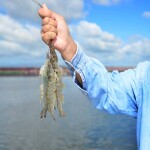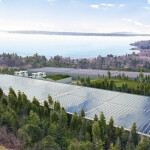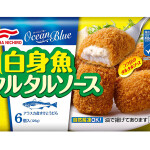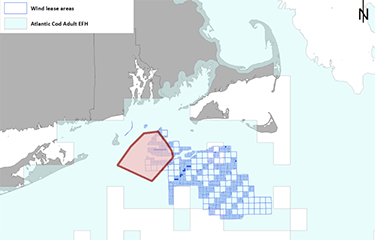The U.S. National Oceanic and Atmospheric Administration is considering whether to outline a “habitat area of particular concern’ in and around offshore wind lease areas off southern New England.
The proposal, originated by the New England Fishery Management Council over concerns of how wind development will affect essential fish habitat, would include Cox Ledge, an important bottom area for cod spawning. NOAA, the U.S. Bureau of Offshore Energy Management, fishermen, and wind power developers have grappled for years over how to build turbine arrays while protecting cod habitat in the region.
The often-bitter debate was one factor in the 1 September mass resignation of the Rhode Island Fishermen’s Advisory Board, whose members charged the state Coastal Resource Management Council is too deferential to wind development interests at the expense of habitat and fisheries impacts.
On 26 September, NOAA Fisheries published the proposal for a formal habitat of particular concern (HAPC) designation around Cox Ledge and wind energy leases in the Federal Register, opening a 30-day public comment period.
“The proposed designation would focus on important cod spawning grounds and areas of complex habitat that are known to serve important habitat functions to federally managed species within and adjacent to offshore wind development areas,” according to a notice published by NOAA Fisheries. “Complex benthic habitat provides shelter for certain species during their early life history, refuge from predators, and feeding opportunities.”
If the HAPC is adopted, it would bring additional conservation focus when NOAA Fisheries reviews and comments on federal and/or state actions that could impact essential fish habitat – such as BOEM’s reviews of offshore wind energy construction and operations plans.
Such consultations can provide “non-binding conservation recommendations,” according to NOAA. However, “an HAPC designation does not provide any specific habitat management measures, such as restrictions on gear types, harvest levels, fishing locations, offshore wind survey and construction activities, or other activities with adverse effects on habitat in the area,” according to the Federal Register notice.
The proposal includes the New England council’s preferred alternative for a Southern New England HAPC designation, identifying habitat that overlap offshore wind lease sites.
The spatial extent of the proposed HAPC “is based on the footprint of the lease areas, buffered by approximately 10 kilometers (5.4 nautical miles) on all sides, combined with the footprint of the Cox Ledge spawning ground, which is based on recent evidence of cod spawning activity,” according to the Register document, which includes charts and graphics prepared by the council.
The buffer areas recognize that some development and construction activities – pile driving for example – “can generate impacts at scales of tens of kilometers beyond the site of construction and operations,” the document notes.
The HAPC area would be designated essential habitat for species from eggs to adults, including Atlantic cod, Atlantic herring, sea scallop, little skate, monkfish, ocean pout, red hake, and winter skate.
In a resignation statement, the Rhode Island Fishermen’s Advisory Board said state officials have allowed wind development plans that violate Rhode Island’s own special area management plan and its protections for fish habitat.
The state has condoned “industrial construction and literal plowing of glacial moraine in violation of the Ocean SAMP’s environmental protection requirements, the decimation of cod spawning grounds and adverse ‘population level impacts on Atlantic cod’ per NOAA, significant long-term impacts on Rhode Island’s fishing industry in violation of the Ocean SAMP’s enforceable policy, and open water cooling systems not even allowed in the state, receiving power from the project to be constructed on top of spawning grounds, to name a few,” the advisors wrote.
Reporting by Kirk Moore
Image courtesy of New England Fishery Management Council







